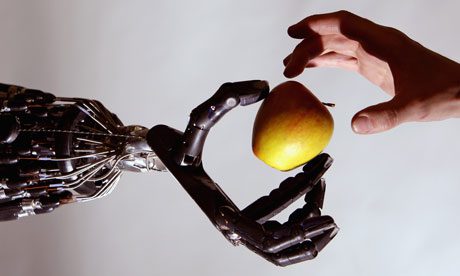The defining difference between a connected world and the offline world as we know it is the presence and role of data. We won’t find data on sandy beaches, floating around in our soup, or growing inside our planet’s vast flora and fauna. But when we embed connectivity into the worlds objects, systems, animals, plants and people, we are literally infusing aspects of their existence with data streams. In a very real way, connecting things to the Internet gives each thing a sort of voice; an ability to communicate and interact.
A Way to Speak and a Way to Be Understood
There are two basic ways so called ‘data dialogues’ work in the Internet of Things:
- Explicit dialogue occurs when objects interactions are driven directly by the user and/or brand. Users input, interact with, or solicit requests directly from the object (e.g. using a mobile app miles from home to close the garage door you forgot to close or turn off the heat via smart thermostat). Brands or manufacturers can then respond in near-real time, whether automated or via service personnel. In a functional sense, these dialogues supplement, or provide historical record of, object interaction. Explicit dialogues also enable consumers to communicate directly with brands through connected objects (e.g. Amazon’s Kindle’s Mayday button, Pizza Hut’s Connected Table [concept]). The user/consumer actively participates in this communication, akin to dialing a support number or sending a tweet directly to a brand handle.
- Implicit dialogue, on the other hand is largely invisible to the user/consumer. Implicit dialogue occurs when consumer interaction and/or product behavior is tracked by use and automatically reported back to the brand. Connecting objects and products to the internet implies a data connection, and this connection is not only available to the thing’s manufacturer, but will increasingly be sliced and diced for a variety of purposes. Implicit dialogues are also where infinite levels of customization are possible: through software and hardware development, engineering, and design, humans can now remotely monitor through sensor technology Just. About. Anything.
Coca-Cola’s smart “Freestyle” soda machine illustrates how one brand is automatically gaining tremendous consumer-product insight while providing consumers a brand new and incredible soda machine experience. Other examples include all connected wearables, any smart device, equipment, or appliance where frequencies of interactions or product functions are digitalized and collected.
If we think of the Internet of Things as an opportunity for humans to better understand ourselves, how we do things, and the world around us, these dialogues are what enable that knowledge. At a very basic level, they are what allow humans to interact with technology and technology to interact with humans, at once.
Historically, such machine-to-machine (M2M) communications are coined as “smart” because they transmit information without human interaction. But human interaction has an important role in the Internet of Things, arguably equally important as those interactions that don’t require humans. I am conducting research on this topic, from a consumer standpoint, as we speak. Feel free to get in touch if you have insights to contribute!
The Use of These Dialogues Will Make or Break IoT Adoption
But it’s not all just open communication, and peace, love, and harmony. These dialogues, particularly those inherent, or automatic to connected products, are the culprits through which privacy can be breached; security can be compromised, experience can be ruined, and loyalty abandoned.
When Target used data-crunching algorithms to (correctly) predict a teenager’s first trimester pregnancy (much to the surprise of even her own father!), we witnessed a brand taking these data correlations a step too far. When these one or two-way data streams get into nefarious hands, or are used in ways that are cost-inducing, embarrassing, cumbersome, or just plain creepy, the value of IoT evaporates.
As technologists, futurists, marketers, early adopters, and engaged consumers, we must understand the role of implicit and explicit data dialogues. These dialogues are important because they provide context to product and consumer experiences and institutional or industrial operations in ways that have, hitherto, never been possible. However, it is the use of these dialogues wherein lie the greatest risks and opportunities to realize the VALUE, and subsequent adoption of a connected world.


